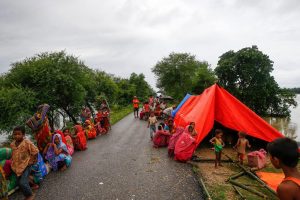
People displaced by the floods take temporary refuge along a road in southern Nepal. Photo: UNICEF Nepal/2017/NShrestha
August 2017– Seasonal flooding from monsoon rains causes widespread devastation in Himalayan foothills in Nepal, Bangladesh and India. Estimated 1200 people killed and 40 million people affected. Read more.
October 2016– The military and Sherpas complete drainage of Imja glacial lake near Mount Everest by 3.4 meters. Read more.
November 2016– Paris Climate Agreement entered into force.
July 2015– Landslides in western Nepal near Pokhara kill estimated 29 people. Read more.
May 2015– 7.3 (major) Earthquake centered east of Kathmandu. Read more.
April 2015– 7.8 (major) Earthquake near Gorkha resulting in over 8,000 deaths. Read more.
April 2015– Nepal approves 1.6 billion USD hydropower project by China’s Three Gorges. Read more.
Background
Nepal’s monsoon season (June to September) brings heavy rains and triggers landslides every year. Over 6,000 rivers and streams increase the threat of flooding in Nepal, especially across the Terai region. Although flooding (including glacial lake outburst flooding) and landslides are the most common natural disasters that Nepal faces, drought, wildfires, and earthquakes also pose serious threats to Nepali livelihood. Dangerous and unpredictable conditions make many activities particularly risky during monsoon season such as transportation (of people and goods) and agricultural activities. Over 80% of the Nepali population live in rural areas, many relying on subsistence farming. The poor, uneducated, and unemployed people who remain most vulnerable to disasters tend to settle the flood and land slide prone areas including steep slopes and low-lying regions. Due to deep poverty, rural inhabitants often have no resources to recover from disasters. Families will often return to these vulnerable areas after monsoon season to maintain access to resources such as fertile land and water. Relocation to avoid disasters is seldom an option for poor families (Newar).
South Asia Floods Kill Estimated 1,200 People
Floods across India, Bangladesh, and Nepal have affected 40 million people. Rains have caused landslides which have killed over 100 Nepali people and damaged homes, land, and infrastructure across the Himalayan foothills. The growing flood waters and continuous rainfall threaten people’s water, sanitation, health, and shelters while relief aid is arriving and being dispersed. Other concerns that the flooding has sparked include waste management (as garbage and wastewater fill the roads and waterways), travel (accessibility to public transit is restricted/limited), productivity (schools and businesses shut down), and power outages (Siddique).
Disaster Preparedness and Response
Governments continue to struggle to support affected populations and speed up recovery from monsoon floods as impacted areas continue to see rainfall and communities remain stranded in waist-level waters. The immediate basic needs of disaster victims and affected communities have tended to overwhelm governments and organizations, limiting or restricting resources (and time) dedicated to long-term prevention strategies. Without established, nationally coordinated preparedness strategies (that optimize the resources and skills of response teams and involve stakeholders in planning), Monsoon season will continue to devastate the poorest communities in the Himalayan foothills while reducing their resilience to future disasters.
Works Cited
Newar, Naresh. “Nepal’s Poor Live in the Shadow of Natural Disasters.” Inter Press Service IPS, 11 Aug 2014. www.ipsnews.net/2014/08/nepals-poor-live-in-the-shadow-of-natural-disasters.
Siddique, Haroon. “South Asia Floods Kill 1,200 and Shut 1.8 Million Children Out of School.” The Guardian, 30 Aug. 2017. www.theguardian.com/world/2017/aug/30/mumbai-paralysed-by-floods-as-india-and-region-hit-by-worst-monsoon-rains-in-years.
